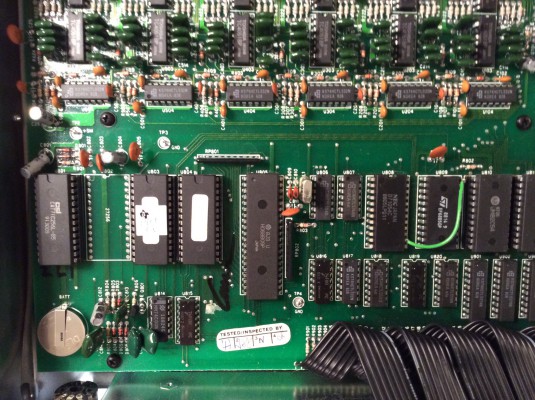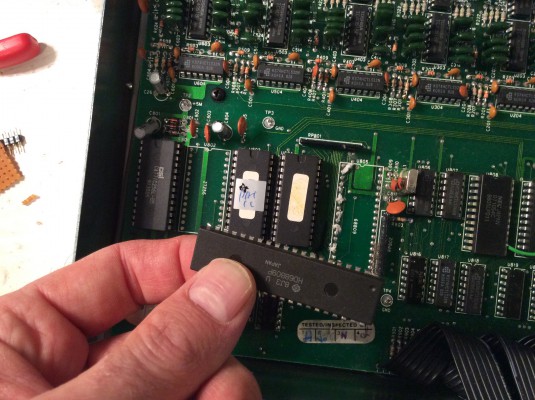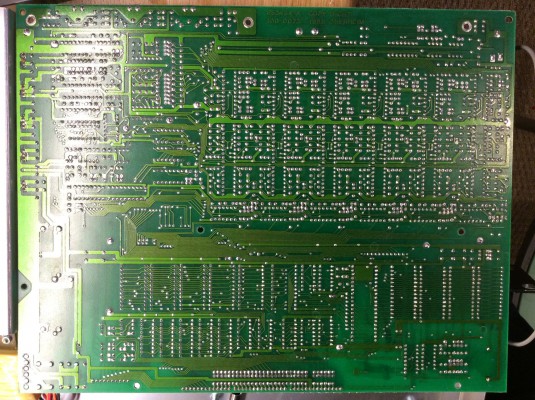 Dremeling and ripping out the brain of a 25-year old vintage machine – I was so Frankenstein yesterday. Luckily, it worked, being the first step to a much improved Oberheim Matrix-1000 running with – at least – doubled system clock, and patched firmware. This takes up the work of Gligli who was the first to hack a faster CPU into the Matrix, and tries to take it one step further.
Dremeling and ripping out the brain of a 25-year old vintage machine – I was so Frankenstein yesterday. Luckily, it worked, being the first step to a much improved Oberheim Matrix-1000 running with – at least – doubled system clock, and patched firmware. This takes up the work of Gligli who was the first to hack a faster CPU into the Matrix, and tries to take it one step further.
Hacking a vintage instrument – my favourite guitar player calls this cruelty. Yet there are good reasons to do it: As I’ve mentioned before, the Matrix’ CPU is actually too slow for what it tries to achieve, but the 8-bit 6809 chip could only be clocked to 2 MHz in its fastest version, and this is it.
So Gligli, a hacker from France known for his Prophet-600 firmware rewrite/retrofit, had the idea of using a 6309 CPU, a chip from the same era that, while maintaining drop-in compatibitily, offered faster instructions and could be overclocked to 4 MHz. So he replaced the CPU and the main oscillator, patched the firmware and – it worked.
Yet there are some issues with Gligli’s solution, in my humble opinion. The Matrix’ peripheral chips are designed to work at 2 MHz; by doubling the CPU clock, they have only half the time to read or write data to the bus. Not all of the hardware is up to this; Gligli’s solution is simply writing everything twice, and that seems to work, but it’s not very trustworthy.
So I’m planning to install a CPU with a custom clock generator that is using asymmetrical cycles to give the peripherals more time to read and write. (I’ll have to build in new oscillator circuitry anyway, as I happened to buy 63C09E CPUs, which rely on external clock generation.) And there’s always the possibility to go even further and replace the CPU by a modern programmable logic chip, an FPGA, that can be loaded with a 6809-compatible core clocked even higher and has proper slowing-down logic to interface the old hardware. More on that later, suffice it to say that I simply want my Matrix’s CPU in a socket. And be it only to be able to revert to the original chip.
Ripping out an 8-bit brain
This is what the unmodded Matrix CPU looks like – as you can see, they did not bother to put in a socket; the only socketed parts in the synth are the ROMs, the four DCO clock counters – important for later hacks and replacements – and the CEM3396 Curtis chips, the analog hearts of the synthesizer. Even the battery has been soldered in, and I’ve got that funny feeling that it may be high time to replace it after a quarter of a century of uninterrupted service.

Top view on Matrix PCB: battery in lower left corner, above it (from left to right): RAM, spare slot for additional sound ROM, preset sounds, firmware PROM, 6809 CPU. Even further to the right you can see the system timer, the UART, and the DCO timers.
So the first thing is to get the old CPU out. I visited our local hackerspace to do this; and one of the guys there had the idea to actually cut the chip out with a Dremel rather than cutting off each of its 40 legs with a clipper.
I decided to keep the CPU; as mentioned above the 6309E chips I got are no drop-in replacements, which a standard 63C09 is supposed to be. I soldered it to two 20-pin pinstripes, and although it does not look to nice, it is still usable.
To install a CPU socket, the remains of the CPU legs have to be removed. I learned that it’s better to use a medium-sized soldering iron rather than a fine SMD solderer, together with a hand-operated vacuum desolder pump and a bit of desoldering wick to clean up. It is also a good idea to remove the main board from the housing to get to its underside.
It was a messy job, but in the end, it worked. Testing all connections found no fault, and as you can see from the first picture in this post, the Matrix-1000 is still running, awaiting further upgrades. They should be possible now avoiding further brain surgery.
Notes
- The battery still has to be replaced with a battery holder; I think it’s the easiest to use a standard type and drill two little holes for it.
- A hacker friend of mine thinks that it’s a good opportunity to replace the quarter-century-old electrolytic capacitors too to keep them from dying onstage.
- What has actually died in these past 25 years is not the battery, not a capacitor, but one of the rare CEM3396 chips. One of its two generators is no longer working; moving around the chip in the synth makes the problem move as well so I think there’s really no alternative to replace it. A couple of them are still around, maybe I’m lucky, maybe I’ll have to buy one of the wide-body variant and adapt the Matrix-1000 to it.
Verwandte Artikel:
- Midifying Jenny, Step 1: Replacing the old keyboard chip with a Teensy (Sunday, 6. January 2019; Schlagworte: Arduino, Jen SX-1000, Löten, Midi, Modding, Retro, Synthesizer, Teensy)
- Resetting a Matrix-1000 with a new battery (Sunday, 10. January 2016; Schlagworte: battery, factory reset, Firmware, Matrix-1000, Oberheim, real time control)
- Could you also patch an Alesis IO Dock II? (Monday, 25. May 2015; Schlagworte: Alesis IO Dock, IO Dock II, Modding, USB hack, USB Hub)



Hi. Every time I come across with someone who bothers to dig into the matrix 1000 and tries to make tweaking the parameters smoothly i get a decent amount of excitement. It really is a sonic wonder that deserves that option. I started to build custom controller for it. That is combining livid brain, lemur running on an ipod touch and all that in a box with keys. Im in a testing state at the moment and surely feel the advantage to have a physical knob per parameter. Of course including the matrix part. As you know well the dream would be to speed up the internal engine so that it starts to function without freesing and glitching. So therefore i really do encourage you to keep up the noble work and keep the hungry wolves updated. And if youre seeking for the replacement for the broken cem3396 here is a web shop to get it http://www.maad.net/ms6/web_shop.html. I ordered a full set and everything worked out perfectly. Plus it is the cheapest option i found so far.
Best from estonia,
Mart
Cheers Mart for the kind words. And yes, that’s exactly the guy who sold me the replacement CEM3396 :)
I’ve been lacking the time but I really hope I can get this thing right – fool the old hardware into working with a CPU that is running slightly out of spec, thanks to skewed clock cycles that leave enough time to read and write the registers. (The reports from the guys who tried the same mod as Gligli seem to be patchy, so it’s possibly a question of luck and parts tolerances whether it works OOTB).
Meanwhile, Gligli, the guy who started this, is improving on his firmware patches; right now he’s implemented a programmable unison detune. Strong stuff.
hi, i’ve just repaired my 3rd Matrix 1000. I have found the voice chips are rarely the problem and its more likely a failed 4053 (next to DAC) or one of the pair of 4051s behind each voice chip. There are also a pair of 4051s just off the DAC that handle “RES” and Wave “BAL”, they seem to fail too.
If you can’t find narrow CEM3396s there is an adapter you can use, so you can adopt the wide-body CEM3396.
Keystone 106 is a nice battery holder that fits.
Guess I was just unlucky there; 4051s and 4053s are so much easier to get :) Funny that the wide-body variant of the 3396 in the Matrix-6 seems to be less in demand and less likely to fail – but that may just be due to the much higher of M-1000s built. Very good hint about checking the 4051/4053 chips.
I’ve just got hold of a 2nd M1000 needing only basic maintenance so far – swapping out the battery and a scratchy volume pot. I think I’ll also equip it with Gligli’s V116 rom then. Getting my sketch for the faster CPU to run is a bit off now though as I want to get my JEN synth back to 1A condition first. So much to try, so little time.
Hi! I can’t hear OSC2 on any of my 6 voices. OSC1 works fine on all of them though. Do you think it’s due to a faulty 4051? I’m trying to identify which is the one on the schematics but it’s not an easy task..
hi,
if a voice has gone and they can also ‘fade’ somewhat you need to check the 4051/4053. A good early heath-check is to check TP12 and see what you get. A misbehaving unit will give you 4.5v instead of 5.5/5.6v
Wide-body dissipates heat and if you rack the M1000 expect a shorter life-span as it gets quite hot.
Scratch vol pot is just a case of lubrication. no need to swap out its a potentiometer and probably last for ever.
I think the Toshiba 4051/4053 were sub-standard and you get new ones from Texas 20pence, they are still in production. Another way to tell if your CMOS chip is exhibiting ‘latch-up’ and failing is to see if the letter is slightly faded or if it gets really hot, they operate quite warm as it is.
Thanks! Might really be a good idea to spend the couple of cents on TI replacements. But in my case it was really the 3396 – I swapped them around and could definitely trace the error back to one faulty chip.
I’m not quite with you on the topic of lubeing old pots back to life though. I’ve put the complete argument down here, the punchline being that solvents tend to work for a while but tend to worsen the problem in the long run. And they won’t fix scratches either so for vintage equipment like the Matrixes I think it’s worth replacing the mechanical part.
sure but something popped that 3396. it only takes CV volts for the most part , apart from the supply. was the 3396 completely dead?
One of the wave shapers was no longer operational. – I’ll go for TP12 ASAP and have a look into the matter. Cheers!
This is pretty basic but wondering if anyone has found a good aftermarket PSU for the Matrix 1000? I have bad one (massive vibration hum) and need to replace it. Any ideas on something from this century that would work?
Well, you could use a standard PSU from an old laptop – it’d have to provide +5V, -5V, +12V, and -12V (which they usually do). The M-1000 uses about 17W, this is well within spec for a laptop PSU. Should not be too hard or expensive to get, grab one from a junk sale for experimenting.
The mechanical approach also has its charms, in my opinion. As the notorious Matrix-1000 hum is purely mechanical – the magnetic leakage from the transformer making the steel housing vibrate – it is worth trying a combination of damping and shielding: shielding the transformer with a steel plate folded over it, and damping the housing’s vibration by wedgeing in some elastic material like gum or foam.
There’s a fix documented at gearslutz that mentions replacing the old noisy transformer with a more modern switching power supply: Mean Well RQ-50B: 45.5W AC/DC Enclosed Switching Power Supply
I haven’t personally done the mod yet but I have two of them on the bench. The Mean Well RQ-50B are much cheaper now than they used to be at $17.50. I think I originally paid $40 USD each for mine.
https://www.gearslutz.com/board/electronic-music-instruments-and-electronic-music-production/1006972-oberheim-matrix-1000-psu-fix-guide.html
Thank you! This is a good idea, and a good alternative to the more traditional solution to the problem: Getting a toroidal transformer as a replacement. They are a bit hart to get by, so choosing a standard PSU as a replacement – one that is used for laptops, for example – looks like a good alternative.